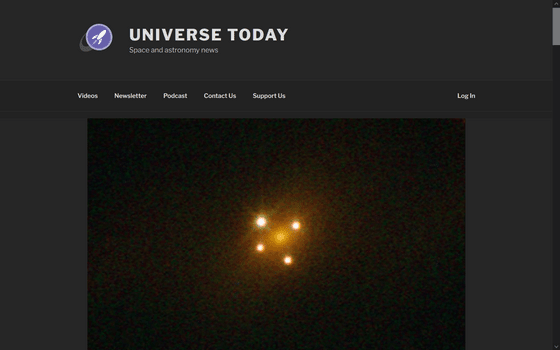Astronomers newly observed ``Einstein's Cross'' that Einstein predicted ``humans will never see''

Light emitted by a star far away from the Earth may appear bent or deformed due to the influence of celestial bodies between the star and the Earth. Among these lights, it has been revealed that a new light called ``Einstein's cross'' has been observed, which splits into four parts (top, bottom, left and right) and looks like a cross.
DESI-253.2534+26.8843: A New Einstein Cross Spectroscopically Confirmed with Very Large Telescope/MUSE and Modeled with GIGA-Lens - IOPscience
Astronomers Spot Rare Phenomenon That Einstein Predicted We'd Never See
https://www.inverse.com/science/astronomers-spot-rare-phenomenon-einstein-predicted-never-see
Astronomers Find a Rare 'Einstein Cross' - Universe Today
https://www.universetoday.com/162565/astronomers-find-a-rare-einstein-cross/

Einstein's Cross is named after physicist Albert Einstein. Einstein proposed the theory that light is distorted and appears to split due to the gravity of celestial bodies, but he expressed the opinion that ``there is no hope of directly observing this phenomenon.''
However, astronomers first observed Einstein's cross in 1985. In 1987, an 'Einstein ring' in which lights were lined up in a ring was also observed. Since then, astronomers have recorded dozens of similar lights, and now Einstein's cross has been newly observed by astronomers at the National Institute of Optical and Infrared Astronomy (NOIRLab).
A research team led by Alexander Chikota of NOIRLab observed Einstein's cross using

The five lights visible in the center of the image are Einstein's cross. It looks like four blue-white galaxies surround the orange galaxy, but the four lights are emitted from one galaxy. Analysis revealed that the blue-white galaxy is located approximately 11,179 million light years away from Earth, and the orange galaxy is a celestial object located approximately 5,998 million light years away.

When viewed from Earth, the blue-white galaxy is directly behind the orange galaxy. The light emitted from the blue-white galaxy is influenced by the orange galaxy, which has a very large mass, and instead of passing straight through the galaxy, it follows a curved path that goes around the galaxy.
In this way, when very distant celestial bodies line up in a straight line, the light from the distant celestial bodies is stretched out, distorted into an arc, or slightly bent. If the celestial object in the foreground is a sphere, an Einstein ring will be formed, and if it is an ellipse, an Einstein cross will be obtained.
``Thanks to space telescopes such as Euclid and Nancy Grace Roman , there will be many more discoveries over the next 10 years,'' said Chikota and his colleagues.
Related Posts:
in Science, Posted by log1p_kr







